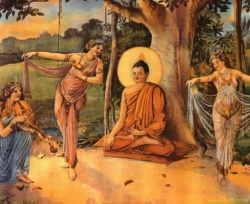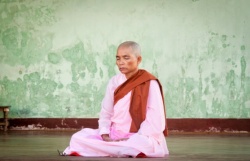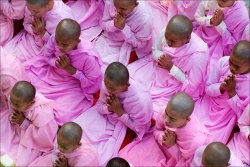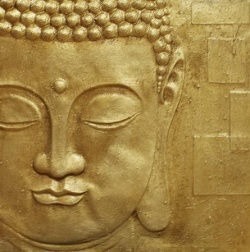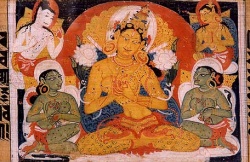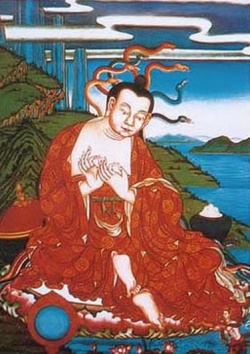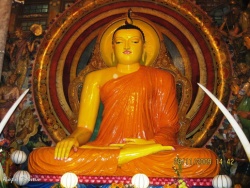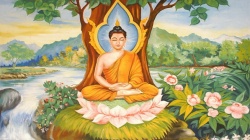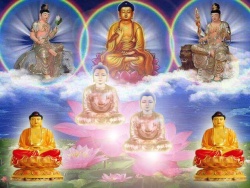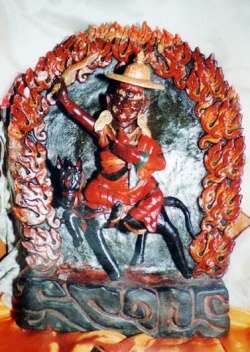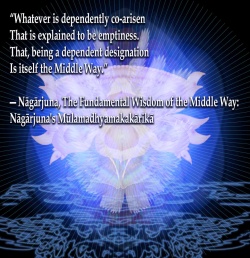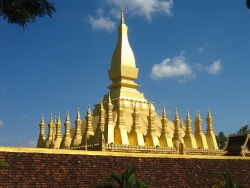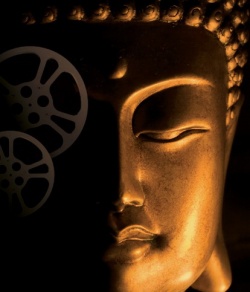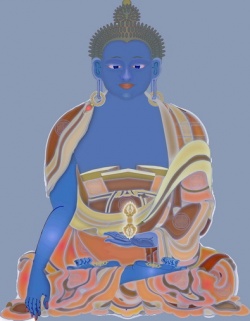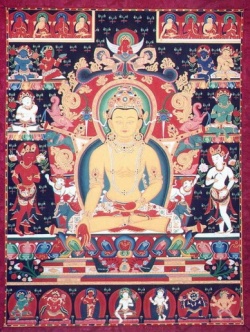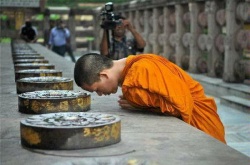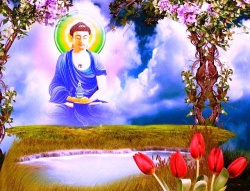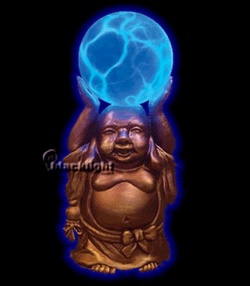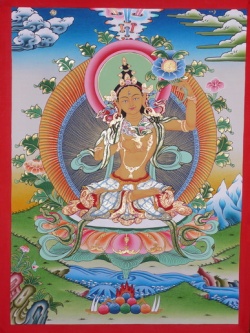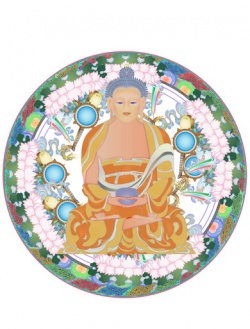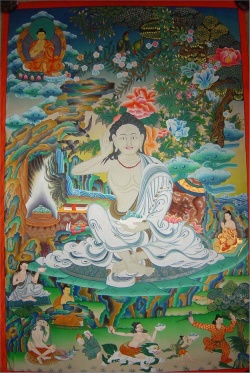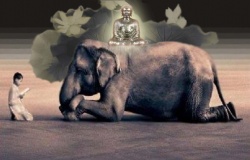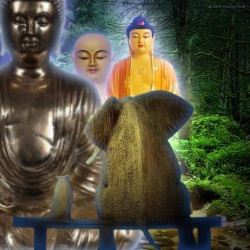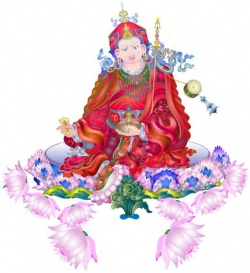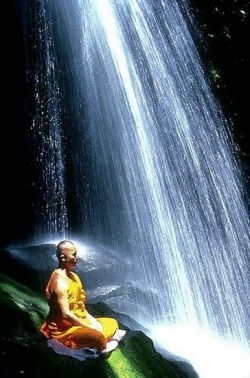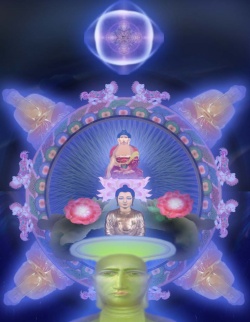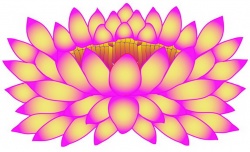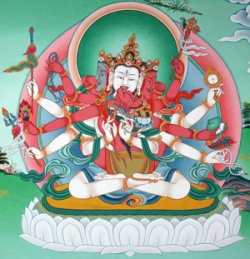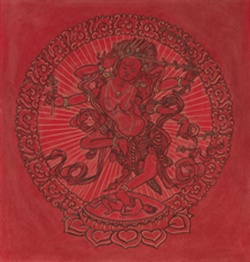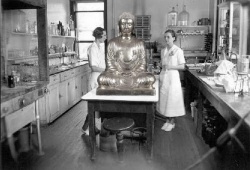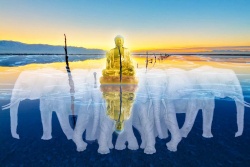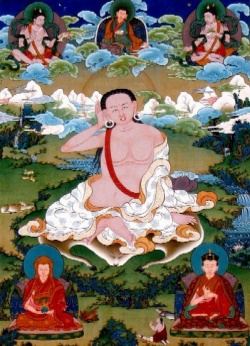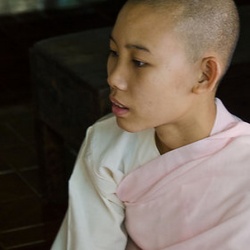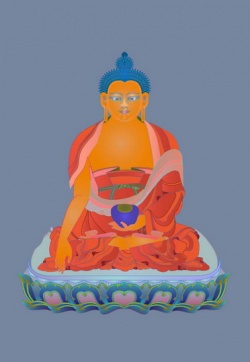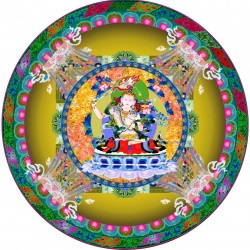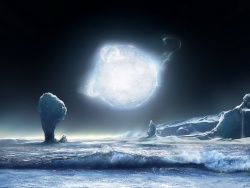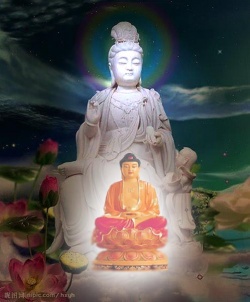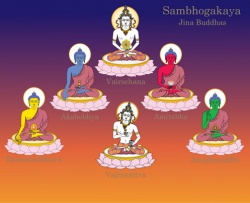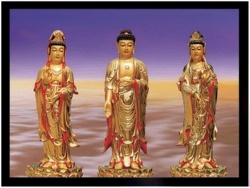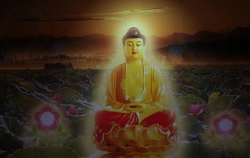Great Madhyamaka by H.H. Dudjom Rinpoche
Concerning the subtle, inner Great Madhyamaka of definitive meaning, it is stated in the Jewel Lamp of the Madhyamaka by the master Bhavya (skal-ldan):
- The Madhyamaka of the Prasangika and the Svatantrika is the coarse, Outer Madhyamaka. It should indeed be expressed by those who profess well-informed intelligence during debates with [extremist] Outsiders, during the composition of great treatises, and while establishing texts which concern supreme reasoning.
However, when the subtle, inner Madhyamaka is experientially cultivated, one should meditate on the nature of Yogacara-Madhyamaka.
In this way, two Madhyamaka are spoken of, one outer and coarse, the other inner and subtle.
Concerning the latter, the regent Ajita (Maitreya) has extensively analysed the meaningful intention of the topics of vast significance which revealed all things in terms of the three essential natures.
This he did by means of discourses connected with the irreversible intention of the final turning of the doctrinal wheel and with the utter purity of the three spheres [of subject, object and their interaction].
Whereas in the aforementioned tradition of Mind Only, the dependent nature is the ground of emptiness and is explained to be the absolute, empty of imaginary objects of refutation, here it is the absolute reality (chos-nyid yongs-grub) that is claimed to be empty of imaginary objects of refutation. Accordingly, the components, psychophysical bases and activity fields, which are dependently conceived, are said to be a ground which is empty of the imaginary self and its properties; and the ground which is empty of that dependent ground of emptiness is absolute reality.
This ground of emptiness never comes into existence because it is empty of the phenomena of samsara, which are characterised as suddenly arisen and which are divided according to essential stains and substantial faults.
However this ground is not empty of the amassed enlightened attributes of nirvana which spontaneously abide from the beginning.
Accordingly, it is said in the Supreme Continuum of the Greater Vehicle (Ch.l, v.155):
The seed which is empty of suddenly arisen phenomena
Endowed with divisive characteristics
Is not empty of the unsurpassed reality
Endowed with indivisible characteristics.
And in the Commentary [on the Supreme Continuum of the Greater Vehicle, Mahayanottaratantrasastravyakhya, T 4025, p.76]:
- If one asks what is revealed by this passage, the reason for there being no basis of all-conflicting emotions requiring to be clarified in this naturally pure seed of the tathagata is that it is naturally free from suddenly arisen stains.
It contains nothing at all which can be established as a basis for purification, for its nature is reality, pure of divisive phenomena.
So it is that the nucleus of the tathagata (tathagatagarbha) is empty of divisions which may be removed and of the entire nest of conflicting emotions, but it is not empty of the inconceivable attributes of the buddhas which outnumber all the sands of the River Ganges and are non-divisive and inalienable.
Now it is also said that the imaginary implies that attributes are without substantial existence, the dependent that creation is without substantial existence and the absolute that ultimate reality is without substantial existence.
The first two of these [indicate] that the conceptual aspects of the subject-object dichotomy, which are suddenly arising fictions, are empty of their own essence, and the latter refers to emptiness as the naturally expressed, fundamental essence itself which has no substantiality.
Since this (ultimate reality) is naturally pure, it abides, through its function of emptiness, as the enlightened attributes of the buddha-body of reality (dharmakaya), and through its apparitional function as the ground on which the buddha-bodies, fields, celestial mansions and so forth arise.
Through its function of awareness, it is spontaneously present from the beginning, free from causes and free from results, because it is the supporting ground of the ten powers, the four fearlessnesses and the like.
This natural expression of the buddhas, which is called the nucleus of the sugata (sugatagarbha), does not abide as the seed of creation, destruction, transformation, change, increase or decrease, cause or condition, and so forth, and it is ever uncovered, without being an object of metaphor, thought or expression. It is said in the Play of Manjusri (Manjusrivikriditamahayanasutra, T 96):
Sister, although suddenly arising conflicting emotions do emerge in relation to the natural inner radiance, the natural inner radiance cannot be defiled by those suddenly arisen all-conflicting emotions.
And the regent Ajita has said [in the Supreme Continuum of the Greater Vehicle, Ch.l, v.5]:
Uncompounded and spontaneously present,
Unrealised through external conditions,
Endowed with knowledge, love and power
Is the buddhahood possessing the two benefits.
If one were otherwise to apprehend all things as being exclusively empty of their own essence, in the manner of the proponents of intrinsic emptiness (rang-stong-pa), then it is said that according to the same extreme [argument] the buddha-body of reality would also be empty of itself.
The buddha-bodies, pristine cognitions (jnana), fields and so forth would be non-existent, the accumulation of the provisions and purification of obscurations, which depend upon these, would also be nonexistent, and indeed the teachings through which the causal and resultant vehicles reveal all the means of purifying stains, whatever their basis or path, would be diminished. The ground of purification being non-existent, there would be no need to effect purification.
Being empty of pristine cognition, there would be no work on behalf of others and no (enlightened) understanding.
There being nothing existent, even with respect to the relative appearances of the impure dependent nature, there would also be no enlightened attributes to transform these impurities into the pure dependent nature. There would be no self to become the ground of bondage and liberation, and there would be no doctrine to be realised by each one individually.
Many such faults would persist and by nature give rise to the source of unbearable views.
This can be known from quotations such as the following from the Sutra of the Dialogue with Kasyapa from the Sublime Pagoda of Precious Jewels (Aryaratnakutakasyapaparivartasutra, T 87):
- O Kasyapa, whoever, referring to emptiness, relies upon emptiness deviates from this discourse of mine; theirs is said to be a great deviation.
O Kasyapa, it is better to abide in a view [which clings to] individual existence to the extent of Mount Sumeru, than with manifest egotism to adopt a view to emptiness.
If you ask why, O Kasyapa, I have explained that although that which arises from all views is emptiness, Kasyapa, that which exclusively regards emptiness is untenable.
If one were, on the other hand, to object that this would not be emptiness, it is not the case, as the Sublime Sutra of the Descent to Lanka says:
- If you ask what is the emptiness which is the ultimate reality of all things, the great pristine cognition of the sublime beings, it is as follows.
The attainment of the pristine cognition of the sublime beings, which is one's own intrinsic awareness, is empty of the propensities of all views and faults.
This is called the emptiness which is the ultimate reality of all things, the great pristine cognition of sublime beings.
This ultimate reality that is empty of extraneous entities (gzhan-stong), is similarly found in sutras belonging to the intermediate promulgation of the doctrinal wheel.
It is said in the Transcendental Perfection of Discriminative Awareness in Twenty-five Thousand Lines:
- In this context, if you ask what is the emptiness of other substances, it applies whether the tathagatas have appeared or not. As the abiding nature of reality, as reality itself, the expanse of reality (dhammadhatu), the faultlessness of reality, the nature of just what is, the unmistakable nature of just what is, the unalterable nature of just what is, and as the genuine goal, it abides as just what is.
Therefore, this reality, which is empty of extraneous entities, is called the emptiness of other substances. Subhuti, this is the greater vehicle of the bodhisattvas, great spiritual warriors.
And it is extensively mentioned in the Supreme Continuum of the Greater Vehicle, as cited above in the passage (Ch.l, v.155) which begins:
The seed which is empty of suddenly arisen phenomena
Endowed with divisive characteristics...
The nature of this expanse in the minds of sentient beings is like a treasure of precious gems within the earth, uncovered by stains in respect of its own essence, and yet it simultaneously assumes the suddenly arisen forms of samsara, in the manner, for example, of water and ice. It says in the Sutra of the King of Contemplation:
Pure, clear and inwardly radiant,
Undisturbed and uncompounded
Is the nucleus of the sugata.
It is the reality that abides from the beginning.
And in the master Nagarjuna's Eulogy to the Expanse of Reality (v.23):
The water that lies within the earth
Remains immaculately pure.
The pristine cognition within conflicting emotions, too,
Remains similarly immaculate.
Such quotations maintain that the status of the nucleus [of the tathagata) according to the definitive meaning is inconceivable.
This nucleus of the tathagata, with respect to its own essence, is the same throughout samsara and nirvana, without good or evil. As it is said [in the Ornament of the Sutras of the Greater Vehicle, Ch.9, v.37]:
The nature of just what is, in all things, is undifferentiated.
When purified, it is the nature of the tathagata.
Therefore all living beings possess that nucleus.
Such extensive quotations have an intention directed towards the absolute nature, which is unchanging reality. Therefore the Supreme Continuum of the Greater Vehicle (Ch.l, v.51) says:
Subsequently just as it was before
Is the unchanging reality.
When beings are circumstantially classified in relation to the stains which suddenly arise, they fall into three categories. As it is explained in the Supreme Continuum of the Greater Vehicle (Ch.l, v.47):
According to their respective order of being impure,
Purifying that which is impure and being utterly pure,
They are called sentient beings, bodhisattvas and tathagatas.
And in the Commentary [on the Supreme Continum of the Greater Vehicle, p.40]:
- Therefore, those in the circumstance of being impure are called sentient beings, those in the circumstance of purifying that which is impure are called bodhisattvas and those in the circumstance of being utterly pure are called tathagatas.
Similarly, everything appears according to distinctions such as the three vehicles, to differentiations based upon hierarchical classifications such as the ten levels and the five paths, and likewise to ethical hierarchies such as good and evil sentient beings, pious attendants and self-centred buddhas, and sublime bodhisattvas and buddhas. However, the natural inner radiance, which is the expanse of reality and the ultimate truth, pervades everything without [[[Wikipedia:distinctions|distinctions]] between] good and evil or decrease and increase, just as, for example, vases appear to be distinguished according to their quality, there being clay vases, wooden vases, vases of precious gems and so on, while the space within these vases is identical in that it is without qualities. Accordingly, the Supreme Continuum of the Greater Vehicle (Ch.l, vv.49-50) says:
Just as space is omnipresent,
Having a thoughtless nature,
So the natural expression of mind,
The immaculate expanse, is all-pervasive.
Its general characteristic pervades the limits
Of negative and positive attributes,
In the manner of the space
Within inferior, mediocre and superior material forms.
If one then asks what exactly the three circumstances just mentioned are, beings are separated between samsara and nirvana according to the distinction of whether they are liberated or not liberated from the stains that obscure the nucleus. As the same text says:
One covered by the net of conflicting emotions
Is truly called a sentient being.
On becoming free from conflicting emotions
One is called a buddha.
Regarding this threefold circumstance, ordinary persons who are obscured by the great darkness of obscuration have nothing but a portion of enlightened attributes. By contrast, the arhats among the pious attendants and self-centred buddhas are more sublime than them in enlightened attributes since they have gradually reduced the stains covering the nucleus by the greater or lesser potency of the antidotes which have power to remove them. Then, the bodhisattvas appear to be even more sublime, having attained the levels, and surpassed those who have not renounced all aspects of ignorance. Beyond that, the buddhas free from all obscurations appear yet more sublime.
Therefore, this ultimate truth which is the expanse [of reality) is not qualitatively perceived according to its abiding nature by the three lower kinds of sublime being, namely, the pious attendants, self-centred buddhas and bodhisattvas. It is not manifestly perceived by one who abides on the paths of provision and connection except as a mere volition of the scrutinising intellect. Again, although it is partially perceived on the paths of insight and meditation, the expanse cannot be perfectly perceived through these paths, apart from a mere proportion of its enlightened attributes, just as a small child does not perceive the all-encompassing sun apart from the mere glimpse of its rays through an aperture.
As has previously been cited [from the Supreme Continuum of the Greater Vehicle, Ch.2, v.68]:
Because it is not an object of speech,
Is subsumed by ultimate reality,
Is not within reason's domain,
Is beyond exemplification,
Is unsurpassed and is subsumed neither by existence nor quiescence,
The objective range of the Conqueror is inconceivable
Even to sublime beings.
It is on the buddha level that the natural expression [of reality) is directly and perfectly perceived. As explained in the Commentary on the Supreme Continuum of the Greater Vehicle (p.77):
Just as the sun in the sky appears
Through an aperture in the clouds,
In this situation you are not fully perceived
Even by sublime beings endowed with pure eyes of
Intelligence; for their intelligence is partial.
However, Transcendent Lord, you who are the pure body of reality,
Pervading the spacious expanse of limitless knowledge
Are totally perceived by those whose intelligence is limitless.
Would it then be, one might object, that sentient beings become buddhas who have accumulated the two provisions and renounced the two obscurations by means of this naturally radiant expanse, which is effortlessly present in the nature of sentient beings? That is not so, because there are two kinds of renunciation, one that is naturally pure and the other that becomes free from the suddenly arisen stains. The former is the reality which, in respect of its own essence, abides without changing in the fundamental nature of great primordial purity. It is said in the Sutra of the Adornment of Pristine Cognition's Appearance which Penetrates the Scope of All Buddhas (Sarvabuddhavisayavatara-jnanalokalamkarasutra, T 100):
- Manjusri, since the mind is naturally radiant, it is naturally undefiled by all-conflicting emotions, and is only [provisionally] defiled by all the subsidiary conflicting emotions which suddenly arise. That which is naturally radiant is the very absence of all-conflicting emotions. For one who is without all-conflicting emotions, there is no antidote through which all-conflicting emotions should be renounced.
And in the Transcendental Perfection of Discriminative Awareness in Twenty-five Thousand Lines:
- "Kausika, what do you think of this? Are sentient beings created or do they expire?" He replied, "Venerable Subhuti, that is not the case. If you ask why, it is because sentient beings are pure from the beginning."
And also in the same text:
- Since form is naturally radiant, it is pure without all-conflicting emotions. Since feeling, perception, habitual tendencies and consciousness are naturally radiant, they are pure without all-conflicting emotions. Since all manifestations up to omniscience are naturally radiant, they are pure and without all-conflicting emotions.
According to such extensive quotations, natural renunciation is that which transcends the phenomena of consciousness and is a genuine liberation from all obscurations. It is complete from the beginning in ultimate truth because absolute reality is naturally pure.
The second kind of renunciation is the removal of the suddenly arising obscurations by an appropriate antidote. Although, as previously explained, the unactualised enlightened attributes which exist in the ground unrefined by the path are present in the situation of sentient beings, no defect is thereby introduced to this philosophical system because it is not claimed that sentient beings are buddhas free from all obscurations.
In the same way, there are also two kinds of realisation, namely, the naturally present pristine cognition realised through the intrinsic awareness of primordial reality, and the dependently produced pristine cognition realised through the power of meditating on the path. The former is characterised as supramundane, being the naturally present pristine cognition or discernment through individual intrinsic awareness which realises the ultimate reality. Thus [the Litany of the Names of Manjusri, v.l55ab] says:
It is awareness of itself, awareness of others,
And awareness of all.
It is the all-knowing sacred total awareness.
The two fundamental kinds of renunciation and realisation are complete in their own essence, which is the abiding nature of ultimate reality. As the venerable Maitreya [in the Supreme Continuum of the Greater Vehicle, Ch.l, v.154]170 says:
Therein there is nothing to be clarified
And nothing to be minutely established.
Genuinely regarding that genuine reality,
Genuinely perceiving it, one will be free.
The second kind of realisation is that pattern of realisation which is expanded by the power of meditating on the path. It is called the absolute which is incontrovertible because enlightened attributes of obscurationless power are actualised once the two provisions of pristine cognition through meditative equipoise and merit during the aftermath have been accumulated. As the Ornament of the Sutras of the Greater Vehicle (Ch.9, v.22abd) says:
Though there is no distinction
Between the former and the latter,
It is the nature of just what is,
Untainted by all obscurations,
That is held to be the buddha.
Superiority of Great Madhyamaka to Mind Only by H.H. Dudjom Rinpoche
This system, according to which the relative is empty of its own essence and the ultimate empty of other entities, is variously revealed in both the intermediate and final promulgations. However, in particular, the presence of profound, radiant and non-dual pristine cognition, the nucleus of the sugata, as the ground of emptiness is extensively taught in the pitaka of the final transmitted precepts, and in those which speak of all things as merely apparitional aspects of mind.
Derived from these (precepts), certain masters of the past have been obliged to admit that the mind is ultimately real and thereby originated the school of the Vijnanavada [proponents of consciousness), which is one of those known at the present day as the four philosophical systems. While not reaching the genuine intention, that mind described as the mind of which all things are merely apparitional aspects partakes of two circumstances, one under which its intention is directed to the consciousness of the ground-of-all, and the other under which its intention is directed to the absolute reality (chos-nyid yongs-grub).
When the former is intended, it is said not to be the ultimate truth because it is impermanent, the bewildered subject and object being relative appearances. For example, the Sutra of the Adornment of Pristine Cognition's Appearance which Penetrates the Scope of All Buddhas says:
- Saradvatiputra, that which is called mind includes the consciousness of mind and intellect, the mental body, the faculty of the intellect and the base of the intellect. This is what is called the mind. If you ask how emptiness relates with it, Saradvatiputra, the mind is empty of the mind. In it there is no actor. If there were some actor, then its actions would be experienced as such by others. The mind is not manifestly conditioned even by the mind.
Though it is taught that all things are merely apparitional aspects of mind, there is no occasion so to speak in connection with the ultimate truth, for the pristine cognition (jnana) transcending mind, intellect and all aspects of consciousness is revealed in the ultimate truth. Accordingly, it is said in the Sublime Sutra of the Descent to Lanka:
- One who has become without mind, intellect, the consciousness of the intellect, conceptualising thoughts and perception, will become receptive to the uncreated doctrine. O Mahamati, since the doctrine which is apparitionless and divorced from conceptualising thoughts is revealed, this ultimate reality is without order or orderly intervals.
And also [Ch.3, vv.40-1]:
Having renounced the mind and intellect,
Consciousness, perception and thoughts,
The pious attendants who have obtained the conceptualising doctrine
Become the sons of the Conqueror.
Through the distinctions of (buddha-]field and (bodhisattvas'] receptiveness,
[They gain] the virtuous pristine cognition of the Tathagata.
There are, in addition, proponents of the Mind Only philosophical system who hold that consciousness is not transcended in the ultimate truth. But this is simply a subjective perception of samsara, unable to sublimate the world. The ultimate truth is characterised as the uncorrupted expanse, and as the obscurationless pristine cognition which realises it, namely, the supramundane, individual, intrinsic awareness of the sublime beings.
The distinction between these two (views) has been extensively taught in passages such as the following from that [same] sutra of the greater vehicle [Descent to Lanka, p.64]:
- In this context, Mahamati, pristine cognition is of three kinds: mundane, supramundane and most supramundane. Of these, that which having been created is destroyed is consciousness; and that which is neither created nor destroyed is pristine cognition. Moreover, Mahamati, that which falls into the dichotomy of being symbolic or non-symbolic, that which falls into the dichotomy of being and non-being, and that which is created from causes of diverse character, is consciousness; whereas that which is characterised as utterly transcending the dichotomy of symbolic and non-symbolic is pristine cognition. And yet again Mahamati, that which is characterised as accumulating them is consciousness, and that which is characterised as diminishing them is pristine cognition.
- Now these three kinds [of pristine cognition respectively] generate the realisation of individual and general characteristics, the realisation of that which is created and destroyed and the realisation of that which is neither created nor ceases. The mundane pristine cognition is that of the extremists who manifestly cling to theses of being or non-being and of all ordinary childish persons. The supramundane pristine cognition is that of all pious attendants and self-centred buddhas who openly cling to thoughts which fall into individual and general characteristics. The most supramundane pristine cognition is the analytical insight of the buddhas and bodhisattvas into apparitionless reality. It is seen to be without creation or cessation, for they comprehend the selfless level of the Tathagata who is free from theses concerning being and non-being.
- Furthermore, Mahamati, that which is characterised as unattached is pristine cognition, and that which is characteristically attached to various objects is consciousness. And again, Mahamati, that which is characterised as being produced from the triple combination [of subject, object and their interaction]171 is consciousness and that characterised as the essential nature which is not so produced is pristine cognition. Then again, Mahamati, that which is characterised as not to be attained is pristine cognition, since each one's own sublime pristine cognition does not emerge as a perceptual object of realisation, [but is present] in the manner of the moon's reflection in water. On this it must be said [Ch.3, vv.38-9]:
The mind accrues deeds and so forth,
But pristine cognition breaks them down;
By discriminative awareness, too, the apparitionless
Reality and powers are well obtained.
It is the mind which objectifies.
And similarly it is said in the Sublime Sutra of Clouds of Precious Jewels (Aryaratnameghasutra, T 231):
- This doctrine genuinely transcends all written and spoken words. It genuinely transcends the entire range of expressions. It genuinely transcends all verbalisation. It is free from all conceptual elaboration and free from all that is accepted or rejected. It is free from all opening and closing, and free from all sophistry. It is not to be analysed and is not within the range of sophistry. It genuinely transcends the range of sophistry. It is non-symbolic, free from symbolism and genuinely transcends the range of symbolism. It genuinely transcends the range of the childish. It genuinely transcends the range of all demons, and genuinely transcends the range of all conflicting emotions. It genuinely transcends the range of consciousness. It does, however, lie within the range of the indeterminate, dynamic, quiescent and sublime pristine cognition. The individual, intrinsic awareness of these attributes is a topic which is taintless, uncovered, pure, bountiful, supreme, sacred, perfect, permanent, firm, enduring and imperishable. Whether the tathagatas have appeared or not, this expanse of reality is exclusively present.
The inconceivability of the ultimate, sublime pristine cognition, extensively revealed by such quotations, does not lie within the path [followed] by the proponents of the Mind Only system. It is admitted that this naturally radiant, intrinsic awareness, the perception free from the subject-object dichotomy, is itself the true basis of buddhahood, and it is held that the subject is dependently real. It is therefore difficult for anyone holding consciousness to exist substantially in ultimate reality to understand literally the selflessness of phenomena. In the same vein the Sutra of the Descent to Lanka (Ch.10, vv.359 and 358) also says:
Being mind only, it is apparitionless.
Being apparitionless, it is uncreated.
These middle paths
Have been explained by myself, and others too.
Realising that there is only mind,
External substances are clarified.
By reversing the pattern of conceptualising thought,
That path becomes the middle one.
So it is that this intention of the final transmitted precepts, abiding in the Great Madhyamaka of definitive meaning, is clearly revealed in the commentaries of great bodhisattvas and in the compositions of the two promulgators who were masters of the greater vehicle (Nagarjuna and Asanga) along with their followers. Although certain masters may well have developed other systems and tenets elsewhere out of necessity, it is difficult to estimate whether they are ordinary or sublime beings. There may well be occasion to speak in the manner [of these masters) owing to various basic intentions once one has reached the level of the sublime ones, but childish persons like ourselves should understand the importance of not accumulating evil deeds which renounce the doctrine, having clung to a single extreme [view].
If this system [of Great Madhyamaka) were also to be described as Mind Only because the three essential natures are taught therein, then the three essential natures are extensively revealed, too, in the intermediate transmitted precepts such as the Intermediate Mother:
- Maitreya, regard any imaginary form as not substantially existent. One might regard any conceptualised form as substantially existent because thoughts exist substantially, but do not confer independent status upon it. Then you should regard the very form of reality as being disclosed by ultimate reality, for it is neither substantially existent nor not substantially existent.
And again in the Epitome of the Transcendental Perfection of Discriminative Awareness in Eight Thousand Lines (Astasahasrikapindartha, T 3809, vv.27-9):
The transcendental perfection of discriminative awareness (prajnaparamita)
Genuinely depends on three teachings:
The imaginary, dependent and absolute alone.
By negative expressions and the like
All that is imaginary is refuted.
By apparition and other such similes
The dependent is correctly revealed.
Through the fourfold purification
The absolute is well known.
Other than the transcendental perfection
Of discriminative awareness,
The buddhas have no teaching.
Similarly, in the master Nagamitra's Introduction to the Three Bodies (Kayatrayavataramukha, T 3890), the three essential natures are also summarised as the causal basis for the attainment of the three buddha-bodies, and in the Commentary [on the Introduction to the Three Bodies, Kayatrayavrtti, T 3891] composed by the proponent of the Great Madhyamaka, Jnanacandra, the same point is explained. Despite all the definitive structures of the three essential natures which have been set forth in all such texts of Great Madhyamaka, those who propound that they belong not to the Madhyamaka tradition but just to that of Mind Only have not even seen these relevant texts. As the Sutra of the Descent to Lanka (Ch.10, vv.256-7) says:
One who relies on Mind Only,
Does not discern external objects.
Relying on the apparitionless,
Mind Only should be transcended.
Relying on the genuine object of reference,
The apparitionless should be transcended.
A yogin who abides in the apparitionless
Does not perceive the greater vehicle.
Accordingly, after Mind Only has been provisionally taught and then genuinely transcended, the apparitionless Madhyamaka is taught; and when that too has been transcended, the apparitional Madhyamaka is revealed. If that is not reached, it is said that the profound meaning of the greater vehicle is not perceived. It is, in general, erroneous to describe everything expressed by the word mind as the Mind Only doctrine; for there are occasions when the abiding nature free from all extremes, [known] inclusively as the nature of just what is, the genuine goal, the natural nirvana, the expanse of reality, the mind of inner radiance, and the intellect of Samantabhadra, is indicated by the word mind. The Long Mother says:
Subhuti, that mind is not the mind.
The nature of that mind is inner radiance.
One should not therefore mistake that which is spoken of as mind-as-such, the inner radiance transcending the mind of samsara and its mental events, for the Mind Only system which does not transcend consciousness. The latter is characterised in the Sutra of the Descent to Lanka (Ch.3, v.32 and Ch.10, v.486) as follows:
Connected with propensities of conceptualising thought,
The diversity which arises from the mind
And appears externally to mankind,
Is the mundane Mind Only [view].
There is indeed a distinction between the mundane and the supramundane Mind Only which is identical in meaning to the distinction between consciousness and pristine cognition, as previously explained. Similarly, those terms revealed in the most profound (sutras) of the greater vehicle which are synonyms of mind should be likewise known. It would indeed be a grave error to equate the tenets of mundane Mind Only with the great Sage's buddha-body of reality (dharmakaya) and the mass of its inseparable enlightened attributes, exceeding all the sands of the River Ganges, which are inclusively known as the uncorrupted expanse, the inconceivable expanse, ultimate virtue, unchanging and firm reality, truth in the ultimate abiding nature of reality, the primordially liberated buddha-body, freedom from all conceptual elaborations of the four extremes, and renunciation of the two concepts of selfhood. These are spontaneously present, utterly transcending the phenomena of consciousness.
In general, those whose intelligence is authoritative, without falling into prejudice, do not differentiate between the two modes of emptiness (rang-stong and gzhan-stong) when abiding in the Madhyamaka [view], which is the summit of the four philosophical systems dependent on different traditions of promulgation which have been precisely enumerated. This is clearly understood through the respective treatises of the two great masters, Nagarjuna and Asanga, whom the Conqueror had prophetically declared would comment on the intention of the definitive meaning; and in conformity with them, it has been similarly explained by the all-knowing dialectician Ratnakarasanti, the venerable Bhavya, the Guru of Suvarnadvipa, the lord Atisa and others. Even the master Haribhadra gives confirmation of it because, when explaining the intention of the Ornament of Emergent Realisation [in his Minor Commentary, T 3791], he resolves that this non-dual pristine cognition alone is the genuinely existing essence. He then asserts this resolution to be made through the sequence of (discriminative awareness) produced by reflection, or through the yoga produced by the meditation of a yogin on the third level. And he additionally confirms this by explaining the recognition of just what is to be pristine cognition, and by explaining, in his commentary on the essential buddha-body (svabhavikakaya), that the remaining three buddha-bodies, through which it abides, are reality.
In this way, the emptiness directly revealed through the intermediate promulgation is claimed to have the definitive meaning of outright explicit negation in order that it might cut through the egotism of the co-emergent intellect in corporeal beings; as well as through the view of self, which is newly postulated by the philosophical systems of the eternalistic extremists; and through the subjective, conceptual elaborations of those of our own (Buddhist) philosophical systems which propound substantial existence. Since [this intermediate promulgation] teaches that one meditates on emptiness when meditating on nothing at all, and realises just what is when nothing at all is perceived, that (reality) and its significance are indeed perceived. The view of this [promulgation] is therefore in the range of understanding or proper realisation of selflessness.
It is difficult to destroy attachment to superficial characteristics (mtshan-'dzin). However, in order for the discriminative awareness born of study and thought to refute it, the Prasangika and Svatantrika reasoning which cuts through conceptual elaboration is sharp. But when the experiences of meditation are established, it is this tradition of the Great Madhyamaka, as taught in the third promulgation, which is supremely profound and vast. This naturally present pristine cognition, the ultimate truth of the naturally pure expanse, is the original abiding nature of all things, and it is the pristine cognition to be experienced by individual intrinsic awareness. As it is said in Rahula's Praise of the Mother [yum-la bstod-pa, T 1127, attributed to Nagarjuna):
Homage to the Mother of the conquerors of the three times,
Who is the ineffable, unthinkable, inexpressible
Transcendental perfection of discriminative awareness,
Essential nature uncreated and unceasing as the sky,
Within range of the individual intrinsic awareness
That is pristine cognition.
And [in the Sutra of Extensive Play, Ch.25, v.l]:
I have found a nectar-like doctrine
Profound, calm, unelaborate, radiant and uncompounded.
By such quotations, the inconceivable pristine cognition has been illustrated, and through the vision of its nature the ultimate truth is perceived. It is wrong to refer to the mere emptiness, which is nothing at all, as the ultimate truth.
Thus, absolute reality is the pristine cognition of the non-dual nature of just what is. It is indicated by the words buddha-body of reality (dharmakaya) or essential buddha-body (svabhavikakaya) which genuinely transcends the phenomena of consciousness. Yet, also comprised within this doctrine, which is misrepresented as the philosophical system known as the Mind Only, are: the definitive order of the three continua as taught in the way of secret mantra; the definitive order of the ground, path and result of purification and so forth which are adhered to by followers of the greater vehicle in both its causal and resultant aspects, and which include [the terminology] of deities, mantras, embodiments of indestructible reality, supreme bliss, emptiness endowed with all supreme aspects, the imperishable seminal point which is the fundamental support of body, speech and mind; and also the uncommon definitive order of the ground, path and result.
One should know that the intention of the final promulgation, even though not within the path upheld by the proponents of intrinsic emptiness (rang-stong-pa), is without contradiction by examining, one by one, the commentaries of the great lords of the tenth level and the teachings belonging to the tantrapitaka of the way of secret mantra.
Therefore, while the intention of the final transmitted precepts is not the same as that of the mundane Mind Only system in any of its forms, the purposes of the lower phases of the vehicle are gradually gathered within the higher, so that (Mind Only and the like] are not contradictory apart from their vindication of an extreme position. Indeed, one must truly comprehend that the great distinction of the higher over the lower phases is a feature of the precious teaching of the sublime Sugata. Otherwise, after one had been given teaching on suffering, selflessness, impurity and impermanence according to the first promulgation and everything had been established as emptiness according to the intermediate transmitted precepts, if one were then to grasp literally the meaningful intention revealed according to the final transmitted precepts concerning bliss, purity, permanence and true self, without knowing how to accept them with an attitude confident in the four kinds of reliance, one would engage in conceptualising thoughts which would confuse those who require training and wrongly scrutinise the teaching.
With an intention directed toward this, the Commentary on the Supreme Continuum of the Greater Vehicle (p.74) says accordingly:
- To sum up, there are four kinds of individuals who do not possess the eye which perceives the nucleus of the tathagata. If you ask who these four are, they are as follows: ordinary persons, pious attendants, self-centred buddhas and bodhisattvas who have newly entered the vehicle. As it has been said, "O Transcendent Lord, this nucleus of the tathagata is not within the range of those who fall into views concerning worldly existence, who openly delight in deception and whose minds waver towards emptiness."
This same point can also be proven thoroughly from all the transmitted precepts and treatises, but here one will suffice.
The Provisional and Definitive Meaning of the Transmitted Precepts by H.H. Dudjom Rinpoche
When these teachings are allocated between the provisional meaning (drang-don) and the definitive meaning (nges-don), the three successive promulgations of the doctrinal wheel have the same common purpose, that is, to purify the stains covering the single nucleus of the tathagata (tathagatagarbha). They differ only in the greatness of their means which respectively purify the gross, subtle and very subtle stains that suddenly arise to obscure it. Thus, by teachings such as impermanence, the first promulgation arouses the mind from samsara and causes it to approach nirvana. In the second, the three approaches to liberation become an antidote to attachment to superficial characteristics, which include the mundane view of self; and the third intends that the extensive way of the sugatas be comprehended through the topics of that irreversible promulgation. This is extensively mentioned in passages such as the following from the Sutra of the Dialogue with King Dharanisvara (Dharanisvarapariprcchsasutra, T 147):
- Son of the enlightened family, it is in the same way as, for example, a skilled jeweller, who knows well how gems are refined, takes an impure stone from a species of precious gemstones and, after wetting it in dirty salt water, has it cleaned with goats' hair, and similarly after then wetting it in a beverage has it cleaned with a woollen cloth, and afterwards, in the very same way, wets it in a herbal solution and has it cleaned with fine clean linen; when it is well refined, the stainless gem is said to be a great gemstone of the species beryl . Likewise, when a sentient being has first been induced to enter the Vinaya by the disturbing topics such as suffering and impermanence, and has then been made to realise the way of the tathagatas by means of the three approaches to liberation, he subsequently is made to enter the objective range of the tathagatas by the topics of the irreversible promulgation. To enter in this way and realise reality is to become an unsurpassed object of offering.
Thus, the three successive [promulgations] of transmitted precepts are classified into those of provisional meaning and those of definitive meaning. It says in the Sutra which Decisively Reveals the Intention (Sandhinirmocanasutra, T 106):
- The first promulgation of the doctrinal wheel by the Transcendent Lord, through which the four sublime truths were taught to those who enter the vehicle of the pious attendants, is surpassed, circumstantial, of provisional meaning and continues to be a basis for debate. Then, beginning with the Transcendent Lord's teaching that things have no essence, the second promulgation of the doctrinal wheel which teaches emptiness to those who correctly enter the greater vehicle is surpassed, circumstantial, of provisional meaning and continues to be a basis for debate. And then, beginning with the Transcendent Lord's teaching that things have no essence, the third promulgation of the wheel of the exceedingly wondrous and amazing doctrine, which is well distinguished, was revealed to those correctly entering the entire vehicle. That promulgation of the doctrinal wheel is unsurpassed, not circumstantial, of definitive meaning and does not become a basis for debate.
The allocation of provisional and definitive meaning is determined in ways such as these.
The intermediate promulgation has accordingly been allocated provisional meaning because in this turning of the doctrinal wheel the enlightened attributes of ultimate reality, such as the powers of the sugatas, are mostly revealed to be empty of their own essence (rang-stong), though they are not actually empty of their own essence, and because it does not teach that these attributes are well distinguished and without inherent contradiction. For such reasons it is said to be surpassed and so on. Definitive meaning, on the other hand, is allocated to the third promulgation because [therein] things of relative appearance are empty of their own essence and the ultimate reality is empty of extraneous entities, so that the nature of these (attributes) is qualitatively well distinguished and then revealed.
If there are those who say that definitive meaning is contained in the intermediate promulgation because it teaches the transcendental perfection of discriminative awareness (prajnaparamita), but that the final promulgation has an intention of provisional meaning because it teaches the contrary, then they have not made an accurate examination. The attributes, such as uncreated and unceasing original quiescence, which are terms relating to the transcendental perfection of discriminative awareness, are most extensively revealed in the final promulgation and very profoundly revealed in the vehicle of indestructible reality.
However, there is no distinction in the essence of the transcendental perfection of discriminative awareness, which is said to be distinguished as surpassed or unsurpassed depending on whether it is unclearly, clearly or very clearly revealed; for all the limitless (attributes) which are revealed by names such as the nucleus of the sugata (sugatagarbha), the expanse of reality (dharmadhatu), the mind of inner radiance, the naturally pure enlightened family, the genuine goal and the emptiness which is the essential nature devoid of substantiality, are identical in the naturally present, non-dual pristine cognition (jnana). This same (pristine cognition) is the transcendental perfection of discriminative awareness (prajnaparamita). Therefore the master Dignaga [in his Epitome of the Transcendental Perfection of Discriminative Awareness, v.l] has said:
Being the transcendental perfection of
Discriminative awareness,
This non-dual pristine cognition is the Tathagata.
Since it possesses the meaning
Which is to be accomplished,
This term applies to the central texts and path.
The final transmitted precepts are conclusively proven to be the definitive meaning by all (scriptural) transmissions and (logical) reasoning. The Conqueror himself made the classification of provisional and definitive meaning, and moreover, in his own words said:
A monk who is called Asanga
Learned in the meaning of these treatises,
Will differentiate in many categories
The sutras of provisional and definitive meaning.
The final [transmitted precepts) were accordingly allocated conclusive definitive meaning by this sublime (Asanga), whom the Conqueror had prophetically declared would differentiate the provisonal and definitive meanings.
There are, on the other hand, no authoritative passages declaring the intermediate [transmitted precepts) to have definitive meaning and the final [transmitted precepts) provisional meaning. Indeed, even if the proponents of the Vijnanavada could have composed these final transmitted precepts as such, they would have mistaken the correct sequence revealed by the above simile of the refinement of gemstones and by other similes which refer to the medical treatment of ill-health and the study of letters. There would be no need even for the definitive order made by the Conqueror himself and the sublime (Asanga), and there would be limitless other such faults. In addition, after first teaching the provisional meaning and intermediately the definitive meaning to those who require training, the provisional meaning would then be repeated, so that one would be obliged to consider just what is the Buddha's intention vis-a-vis the teaching. It should be known that by proceeding in this way, there would be all kinds of unbearable evils, such as allocating the conclusive definitive meaning to philosophical systems which propound substantial existence, slandering the buddhas and great bodhisattvas as holders of a relative teaching, and abandoning this doctrine of the nucleus (garbha).
Furthermore, since the three vehicles have reference to the definitive meaning gathered in the final promulgation, the definitive meaning is conclusively proven. This is extensively mentioned in passages such as the following from the Sutra of the Irreversible Wheel (Avaivartacakra-sutra, T 240):
- Then, in reverence to the Transcendent Lord, the great bodhisattva Madhuranirghosa arose from his lotus posture and asked, 'Transcendent Lord, what is the dimension of this world system of Patient Endurance?"
He replied, "Son of the enlightened family, in the western direction of this world system there is a world system which outnumbers the sands of the River Ganges."
Then he asked, 'Transcendent Lord, in that world system which Transcendent Lord teaches the doctrine?"
"He is called the Tathagata Sakyamuni."
"What manner of doctrine does he teach?"
"He begins from the three vehicles."
"What are the three vehicles?"
"He reveals the doctrine beginning with the three vehicles, which are the vehicle of the pious attendants, the vehicle of the self-centred buddhas and the greater vehicle."
"Do these conform to the doctrine revealed by the Transcendent Lord Buddha?"
"Son of the enlightened family, the doctrines revealed by the [different] Transcendent Lord Buddhas do conform."
"Just in what respect do the doctrines revealed by the Transcendent Lord Buddhas conform?"
And he replied, "The doctrines revealed by the Transcendent Lord Buddhas conform to the irreversible promulgation."
The Enlightened or Buddha Family by H.H. Dudjom Rinpoche
When this buddha family of the unsurpassed greater vehicle is classified, the Supreme Continuum of the Greater Vehicle (Ch. 1, v.149) says:
One should know this enlightened family to be twofold:
One similar to treasure and the other to a fruit tree.
The [first] is that which naturally abides from the beginning,
And the [second] is supreme through having been genuinely acquired.
So there is both an enlightened family which naturally abides and an enlightened family which is attained. Concerning the former, the Sutra of Final Nirvana says:
- Son of the enlightened family, the reality of the mind which is natural, inner radiance, and naturally without essence is not differentiated by the naturally pure mind as it appears, decorated with the enlightened attributes of blazing major and minor marks, but it is differentiated by its nature of appearance and emptiness.
Therefore, when this enlightened family is classified, it is threefold owing to its function of being the ground in which the culminating three buddha-bodies of the result arise. It consists of [firstly] the enlightened family in which reality naturally abides, which resembles an image made of precious gems in that it is the spontaneously present causal basis or ground separating (bral-rgyu) the essential buddha-body (svabhavikakaya) or the uncorrupted expanse [from obscuration]; [secondly] the enlightened family in which the apparition of this reality naturally abides, which resembles a universal emperor in that it is the causal basis separating the buddha-body of perfect rapture (sambhogakaya) from obscuration; and [thirdly] its apparitional reflection, which resembles a golden image in that it is the causal basis separating the emanational body (nirmanakaya) from obscuration.
In actuality, however, the reality in which these three are of an inseparable essence is the great, naturally present, uncompounded buddha-body of reality (dharmakaya), the pristine cognition of supreme sameness (samata-jnana), coalescing appearance and emptiness without conceptual elaboration. Since it is the great, indivisible reality in which the ground differentiating appearance and emptiness has ceased, it is exemplified by the nature of the Tathagata. As the Supreme Continuum of the Greater Vehicle (Ch.l, v.146) says:
Since it is supramundane, in the world
There are no examples to which it may be referred.
Therefore the nature of the Tathagata
Is revealed to be similar to the seed.
When this enlightened family is actualised without obscuration, the conclusive truth of cessation according to the greater vehicle is the essential buddha-body endowed with two purities.
The [second] enlightened family, the one in which (reality) is attained, includes those who awaken to the [aforementioned] twofold family, in which the expanse, or reality, and pristine cognition, or [reality's] apparition, naturally abide, and those who consequently study to integrate the two provisions of skilful means and discriminative awareness. These two provisions in turn are subsumed by the provisional path of learning (saiksamarga) which includes the generation of enlightened mind, in order that the suddenly arisen stains covering [the nucleus] might be removed. The Sutra of the Arrayed Bouquet says:
- Sons of the Conqueror, this which is called the enlightened family is devoted to the expanse of reality (dharmadhatu). It is one in which, having seen the natural, inner radiance vast as the sky, studies are pursued in furtherance of the great provisions of merit and pristine cognition.
So the former enlightened family is the ground of separation from obscuration and the latter is the path which removes the stains covering [the nucleus]. It is said that though the truth of the path depends on the ground-of-all and is subsumed in the causal basis of separation from obscurations, it does bring about the basis of unchanging authentic liberation. This is because its function of attainment which effects the result of separation [from obscurations) depends on the enlightened family or the nucleus.
For anyone to know that this enlightened family, which naturally abides, does exist, it is inferred to exist through the signs (visible in those who] awaken to it, just as one, in general, infers fire from smoke. The signs that one has awakened to the natural enlightened family of the buddha-body of reality are indicated in the Introduction to the Madhyamaka
One who, having heard about emptiness even as an ordinary person,
Experiences within, sheer delight again and again,
And who, owing to this delight, is brought to tears,
And whose body-hair stands erect,
Has the seed of intelligence which attains to perfect buddhahood.
That one is a vessel for this very instruction,
To whom the ultimate truth should be revealed.
The signs that one has awakened to the enlightened family of the buddha-body of form, which is the apparition of reality, are indicated in the Ornament of the Sutras of the Greater Vehicle (Ch.3, v.5):
Even prior to practice,
Correct conduct with respect to compassion,
Volition, patience and virtue,
Is truly explained to be a sign of that family.
Then, the benefits which result when one awakens to that enlightened family are mentioned, too, in the same text (Ch.3, v.8):
Though a long time has been passed in evil existences,
Liberation will swiftly be attained;
There, too, less suffering will be experienced,
And being disillusioned, one will mature sentient beings.
As long as one has once awakened to this enlightened family, one will not be born in evil existences, and even if one is so born, one will be liberated in merely the time it takes to bounce a ball of yarn. There, too, suffering will diminish, and through strong disillusionment [with samsara), one will indeed bring sentient beings to maturity. In this way it is said that when the Teacher himself (Sakyamuni) became the strongest of charioteers in the hells, he was instantly liberated by awakening to that enlightened family which embodies great compassion, and was born as a god in Trayatrimsa. He subsequently became the boy Bhaskara, the son of a potter, in Jambudvipa and aspired to enlightenment in the presence of the Tathagata Sakyamuni. Similar things are said about the series of his [ordinary] lives in which he took birth as the daughter of a friend and so on.
If living beings were without this enlightened family, those who experience suffering would not even feel regret. It would be reasonable for some not to think that samsara should be rejected and nirvana acquired, and even the desire for liberation would not arise in their minds. However, untaught by anyone, some persons feel compassion when others experience suffering, and are disturbed by the experience of suffering. One should know such phenomena to be the virtuous power of the seed of beginningless reality. It says in the Supreme Continuum of the Greater Vehicle (Ch.l, vv.40-1):
Without the seed of buddhahood,
One would not feel regret for suffering;
One would have neither the desire,
Nor the prayer, nor the aspiration for nirvana.
This perception of suffering as a negative
And happiness as a positive attribute,
In relation to existence and nirvana,
Is present owing to the existence of the enlightened family;
For it is not found in those lacking that family.
Passages which speak of beings belonging to no family or to a cut-off family are rhetorical devices which indicate through negation the baseness in those who have not awakened to the enlightened family. Indeed, there are no living beings who do not belong to the enlightened family which naturally abides. The Sutra of the Nucleus of the Tathagata (Tathagatagarbhasutra, T 258) says:
- Son of the enlightened family, this is the reality of all things. Whether the tathagatas have appeared or not, these sentient beings always possess the nucleus of the tathagata.
And in the Sutra of Queen Srimala (Srimaladevisimhanadasutra, T 92):
The nucleus of the sugata
Completely pervades living beings.
Therefore, the mind is developed in the enlightened attitude of the greater vehicle consequent on awakening into the [first] enlightened family, which has two aspects and is the causal basis. Subsequently, the stains which obscure the buddha-body of reality are removed by experiencing, above all, the non-conceptualising pristine cognition during meditative equipoise; and the stains obscuring the two buddha-bodies of form are skilfully removed by conduct that is relevant to the two provisions with the assistance of illusion-like compassion during the aftermath [of that meditation).
Then, there is obtained the culminating result of this separation from obscuration (bral-'bras), the essential buddha-body. It is defined as an expanse encompassed by inconceivable, uncorrupted, enlightened attributes, or the ground in which the buddha-body of form that appears to others is reflected like the moon in the sky. It naturally manifests as pristine cognition itself, without being extraneously sought, and is endowed with the three bodies of the buddhas manifest in and of themselves. The Supreme Continuum of the Greater Vehicle (Ch.2, v.3) says:
That which is called natural inner radiance is as the sky.
It is unobscured by the dense clouds
Of suddenly arisen conflicting emotions
And ignorance of the knowable.
This buddhahood endowed with all enlightened attributes of the taintless Buddha,
Constant, steadfast and eternal, is attained
Dependent on the pristine cognition which discerns things non-conceptually.
And [Ch.2, vv.38-9]:
Without beginning, middle, or end and indivisible,
Neither two, nor three, taintless and non-conceptualising,
That realisation, which is the natural expanse of reality,
Is perceived by the yogin during meditative equipoise.
Endowed with enlightened attributes that are immeasurable,
That outnumber the sands of the Ganges, limitless and without peer,
This taintless expanse of the Tathagata
Has renounced the entire range of faults, along with their propensities.
Arising from that (essential body), the two buddha-bodies of form have the same uncorrupted pristine cognition. They become naturally present through a co-emergent cause, consisting of the basis of the pure vessel of the beings requiring training, as well as the conditions of their former aspirations and their experience of the two provisions. The maturing result (smin-'bras) of these bodies of form is then established through their function of teaching in forms manifest to others who require training, in the manner, for example, of the moon reflected in water. As the above (Supreme Continuum of the Greater Vehicle, Ch.2, vv.40-1] says:
With a buddha-body which manifests the diverse rays of the true doctrine,
Persevering so that the liberation of living beings be achieved,
Their deeds, like the king of wish-fulfilling gems,
Are without inherent existence despite their diverse forms.
All their forms which cause (beings)
To enter into, ripen and prophetically declare the path by which the world is pacified
Also constantly abide therein,
Just as form occupies space.
And as Nagarjuna [in the Eulogy to the Expanse of Reality, v. 101] says:
Since within the taintless body of reality
An ocean of pristine cognition abides,
The benefit of sentient beings emerges therefrom
In the manner of diverse gemstones.
In short, as [Longcenpa has said] in the Great Chariot (shing-rta chen-mo):
- In this context, one should know that, among the three buddha-bodies, the body of reality, which is an expanse invisible to those requiring training outside the range of the Buddha alone, is present as subtle pristine cognition, the inner expanse that is unique and of a single savour. The two buddha-bodies of form endowed with pure enlightened activity, which are the pristine cognition that manifests to others, outwardly radiate through its blessing and the aspiration of those requiring training. They appear in the manner of the moon in the sky (body of perfect rapture) and the moon in water (body of emanation).
And in the Treasury of Philosophical Systems:
- Since the three buddha-bodies are primordially present as the twofold enlightened family, the apparitional aspect of the buddha level or [the enlightened family] of inner growth is the body of perfect rapture and its empty aspect or [the enlightened family] which naturally abides is the body of reality. From the indivisible blessing of these two, the emanational body gives teaching in form manifest to others who require training, and is exemplified as the reflection of a universal emperor (cakravartin) shining on a golden mountain.
One who, without knowing this, is attracted to the concept that a single uncompounded emptiness of explicit negation is the enlightened family which naturally abides, and that the enlightened family of inner growth is exclusively compounded and newly produced by the path, is found to interrupt the realisation which belongs to the paths of learning as a conclusive result and so to adhere to the cessation of the pious attendants' tradition, which resembles an expired butter lamp in that it establishes no order of buddha-body, pristine cognition and so forth. If one were to take this view, one would not even savour the fragrance of the truth of cessation according to the greater vehicle. In the ground, one would fall into the extreme of conceptual elaboration. On the path, one would not require the two provisions of the greater vehicle. In the result, one would not distinguish between the nirvana of the three vehicles; and as a conclusive result, one could not cross beyond the abyss of nihilism. The refuge of ultimate reality would never be found.
It was with an intention directed toward this mode [of the nucleus] that the all-knowing doctrinal master [Longcenpa] said in the Precious Wish-fulfilling Treasury (yid-bzhin rin-po-che'i mdzod):
One who without knowing this mode [of the nucleus] determines emptiness verbally
As free from extremes of being and non-being
Harbours the view of the summit of existence,
Ignorant of the causal basis of separation from obscuration.
Since he is outside this teaching,
He may as well cover himself with ashes,
Like those who hold the mind to emerge from space.
Such a wrong view is gathered within [the nihilism of] the Followers of Brhaspati (Barhaspatya). The Doha also says:
The Archer says:
"Those who hold the mind to emerge from space
Never attain to liberation."
If one were to think that on the paths of learning one develops anew, by the two causal provisions, what was previously non-existent, then the body of reality, or essential body of the buddha, and the body of perfect rapture would be compounded and impermanent. If one were to hold this view, it is said one would harbour the immeasurable defects of looking upon the continuum [of enlightened mind) as an ephemeral compound; the suffering of change as something unrenounceable; the possession of the body of indestructible reality, which is pristine cognition vast as the sky, as non-existent; and the body of indestructible reality itself as impermanent. Because of such limitless faults, one would deviate from the meaning of the greater vehicle.
So, rather than merely differentiate the twofold enlightened family as being the apparitional and emptiness aspects of a single expanse, it is the flawless intention of the all-knowing doctrinal master [Longcenpa] to establish it to be this supreme essence or natural expression which is indivisible, uncorrupted and uncompounded. In the Great Chariot he says:
- There are nine similes which reveal as spontaneously present the enlightened attributes of the Buddha's body of form, deriving from the naturally radiant apparitional aspect of the taintless mind-as-such, the naturally pure essence, the mind in which the genuine pristine cognition of the Buddha originally abides. And the comparison of its emptiness aspect, the enlightened attributes of the body of reality, with the sky is explained in all the sutras and tantras. However, these two are inseparable in the virtuous seed of beginningless reality. This [seed] firstly is called the enlightened family which naturally abides because it is unchanging, and secondly is called the enlightened family of inner growth because enlightened attributes are extensively manifest after the stains have been purified. Yet its root is inner radiance, the pristine cognition which is intrinsic awareness.
Similarly, in the Extensive Sutra of the Commitments (dam-tshig mdo-rgyas), a teaching of the all-seeing Rongzompa, the naturally present pristine cognition in which the ground, path and result are inseparable, is said to be the mind or family of enlightenment:
- That which is imperishable like a vajra is the mind of Samantabhadra, unchanging like a vajra, because it naturally contains no distinction between [firstly] the enlightened mind of beginningless time [i.e. the ground], [secondly] the provisional mind which is the causal situation [of the path extending] from the development of enlightened mind to the attainment of the vajra-like contemplation, and [thirdly] the mind of the body of reality along with its actions which is the essence of the result, similar to the Wish-granting Tree and the precious Wish-fulfilling Gem.
These quotations serve to illustrate that all the panditas and accomplished masters of the Ancient Translation School, including the king of the doctrine Terdak Lingpa and his brother, have affirmed the same system exclusively. This can be known in detail from the Lecture Notes on the Nucleus of the Sugata (bde-gshegs snying-po'i stong-thun), the Lion's Roar in Affirmation of Extrinsic Emptiness (gzhan-stong khas-len seng-ge'i nga-ro) and the Proof of Mind in its Natural State (gnyug-sems sgrub-pa) along with its branches, which are all teachings of the all-knowing Mipham Jampel Gyepa.
The lord of living beings Atisa, too, has determined in conformity with them that the uncompounded expanse of reality, the coalescence of appearance and emptiness, which is empty of imaginary deeds and defilements, and inseparable from the uncorrupted enlightened attributes is the enlightened family [or the nucleus of the tathagata). In his Song with a View to the Expanse of Reality (Dharmadhatudarsanagiti, T 2314) he says:
Just as the son of a pregnant woman is within her womb
But is not perceived,
So, covered by conflicting emotions,
The expanse of reality is also unperceived.
Since the expanse of reality is not a self,
It [resembles] neither woman nor man;
One should examine just how one clings subjectively
To that which is liberated from all objects.
When the mind is purified by all three actions,
Namely, [the meditations on] impurity, impermanence, and suffering,
The sutras which point out emptiness
Are accordingly spoken by the Conqueror.
Conflicting emotions are reversed by all these topics,
But this seed [of reality) is not diminished.
And also:
The natural expression of reality's expanse,
Like space is without cause or condition:
Without birth, old age, duration and destruction,
Without being compounded,
The inseparable attributes of the Buddha
And, similarly, the attainment of this enlightened family
Are not false, deceptive or harmful.
They are the original, natural quiescence.
Then, among the esoteric instructions of the dakinl entitled Valid Cognition of the Transmitted Precepts (Ajnasamyakpramana, T 2331) which were introduced from Akanistha by Tilopa, it is said:
Just as a butter lamp within a vase
Does not appear outside,
But if the vase is broken,
The lamplight is visible thereafter,
So is one's own body like the vase
And inner radiance like the butter lamp:
When well broken by the guru's instruction,
The pristine cognition of the buddhas becomes radiant.
And in the Ganges Great Seal (phyag-chen ganga-ma, T 2303) which Tilopa imparted to Naropa:
Just as, for example, the nature of space transcends colour and form,
And is uncovered and unchanged by positive and negative values,
So does the nucleus of one's own mind transcend colour and form,
And is uncovered by positive and negative doctrines of virtue and sin.
As the nucleus of the sun, for example, radiant and clear,
Is not obscured by the darkness of a thousand aeons,
So the inner radiance of the nucleus which is one's own mind
Cannot be obscured by the samsara of aeons.
Then, in the Teaching Cycle of Lord Maitripa (mnga'-bdag mai-tri-pa'i gdams-skor) there is the Ten Verses on the Real (Tattvadasaka, T 2236) composed by master Advayavajra, which says:
Since you desire to know, the nature of just what is
Is neither represented nor representationless;
Unadorned by the guru's speech,
Even the Madhyamaka is mediocre.
The great brahman (Saraha) in his Song of Instruction Given to Lord Marpa (mnga'-bdag mar-pa-la gdams-pa'i mgur, DZ Vol. 5) has also said:
Emptiness and compassion are indivisible.
The uninterrupted mind in its natural state
Is the original purity of just what is:
Space is seen in union with space.
The venerable Milarepa has also revealed this in general in Illuminating the Substance of the Aural Lineage (snyan-brgyud dngos-po gsal-byed, DZ Vol.5, pp.443-55) which he gave to Nyiwa Rincen (Gampopa):198
In every corporeal being
This truth of the nucleus originally abides.
Through it sentient beings have the basis of buddhahood.
When one arrives at the result from the cause,
It is reached primordially, not just presently.
Then, particularly in his Song of Indestructible Reality in Answer to Questions Posed in a Trilogy by the Goddess of Longevity, which is the Root of the Aural Lineage of Ngamdzong (ngams-rdzong snyan-brgyud rtsa-ba tshe-ring skor-gsum-gyi zhus-lan rdo-rje'i mgur, mgur-'bum, Ch.29), he differentiates between the two truths, which provisionally have synonyms, beginning as follows:
With reference to the ultimate truth,
Due to negation there is not even buddhahood...
And:
With reference to the relative truth,
The Sage has said everything exists,
Both samsara and nirvana.
He then conclusively evokes the expressive power of ultimate reality for which there are no synonyms as follows:
Since appearances in the form of existing substances
And reality which is non-existing emptiness
Are essentially inseparable and of a single savour,
There is not just intrinsic awareness or extrinsic awareness,
But a vast coalescence of everything.
And finally, he literally reveals the way in which the taintless, sublime, pristine cognition is directly perceived in the following verses:
So, one skilled in realisation
Perceives not consciousness but pristine cognition,
Perceives not the apparition of reality, but reality itself,
And thence the force of compassion emerges.
The enlightened attributes of the buddhas,
Including power, fearlessness and retention,
Emerge in the manner of a precious gemstone.
They are the measure of my realisation as a yogin.
Zhang Rinpoche in his Culmination of the Supreme Path (lam-mchog mthar-thug, DZ Vol.5, pp.744-77) has said:
The buddha-body of reality, or the nucleus
Which is the culmination of definitive meaning,
Is the essentially pure expanse of inner radiance.
Whether the conquerors of the three times appear or not,
Whether it is realised by the sublime assembly or not,
Whether it is spoken of by the sages or not,
Whether it is delivered by learned commentators or not,
This reality which is pure unelaborate inner radiance,
Abides from the beginning, spontaneously present,
Without increase or decrease.
Though the skies have been ravaged over many immeasurable aeons
By the conflagrations, whirlwinds and the like
Which create and destroy the world,
The sky is unharmed, without increase or decrease.
Similarly, the radiant sunlight obscured by clouds
Ostensibly varies in the intensity of its radiance
When the thick darkness and cloud mass dissolve,
And yet the nucleus of the sun neither increases nor decreases.
This unchanging buddha-body of reality, which so abides,
Is nothing other than one's own mind.
The diversity of samsara without exception arises from the mind.
When one's own mind is not realised,
The suffering of the world of samsara and its contents increases
Through the confusion (caused) by erroneous, bewildered appearances.
When one's own mind is genuinely realised,
The limitless pristine cognition of nirvana arises as supreme bliss.
Thus, everything without exception issues from one's own mind-as-such.
If one knows reality in relation to oneself,
One will know reality in relation to all sentient beings.
One who knows that knows all things including nirvana.
One who knows all things completely transcends the three realms.
If that one thing is known, one becomes learned in all things.
The Lord of Conquerors, the venerable Karmapa [III], Rangjung Dorje, has additionally given an extensive explanation of the classification of the enlightened family in accordance with the transmissions of the Supreme Continuum of the Greater Vehicle and the Collection of the Greater Vehicle in his autocommentary on the Profound Inner Meaning (zab-mo nang-don). Therein he says that the enlightened family of inner growth is not to be regarded as newly arising, as is the opinion of some. In such ways he clearly reveals [the family] to comprise both the expanse [of reality) and pristine cognition. That is, the expanse of reality is the enlightened family which naturally abides, and the pristine cognition, pure in respect of the eight aggregates [of consciousness), is the enlightened family of inner growth. Indeed, he proves both of these to be naturally pure in accord with the transmission of the Analysis of the Middle and Extremes (Ch.l, v.17) which he quotes as follows:
The same point is also clearly revealed in his Two Short Treatises (gzhung-chung gnyis).
The venerable Karmapa VII (Chodrak Gyamtso) asserts, too, that the expanse or emptiness in which the sixty-four enlightened attributes are inseparable is the emptiness endowed with all supreme aspects. These and the statements made by the All-Knowing Situ [VIII, Dharmakara) and others are renowned among the Kagyupa traditions.
Again, in the Commentary on the Eulogy [entitled Taintless Gem Rosary, i.e. bstod-'grel, SK Vol.5] which is his culminating personal statement, Sakya Pandita first establishes the way in which the character of the mind is obscured by suddenly arisen stains despite the mind's naturally pure reality. He then establishes the ways in which the stains can be purified since they are suddenly arisen and buddhahood attained by their removal. At this point, he sets forth the intention of the Collection of Madhyamaka Reasoning (Yuktikaya, T 3824-8) that, with reference to reality, there is no transformation at this moment [of buddhahood), and the intention of the Collection of Eulogies (Stavakaya, T 1118-36) which is that, with reference to the apparitional mode of enlightened attributes, there is transformation [of consciousness into pristine cognition). Then, after setting forth the viewpoints, one of which holds that these two [[[Wikipedia:intentions|intentions]]] are essentially not contradictory and the other of which holds that there is no pristine cognition in buddhahood, he offers his personal statement, refuting the assertions that there is neither the pristine cognition nor the body of buddhahood, and says that these two [[[Wikipedia:intentions|intentions]]] are inseparable.
Furthermore, in his Answers to the Questions ofNyemo Gomchen (snyi-mo sgom-chen-gyi dris-lan, SK Vol. 5) it is said by way of illustration:
- When the mind is realised to be empty, it cannot be estimated according to [the standards set in] the three pitaka and the four tantrapitaka, for that is equivalent to the cessation of the pious attendants; but when it is realised to be coalescence, such an estimation can be made. In the exclusively empty aspect of mind, the Three Precious Jewels are incomplete. In the coalescence of awareness and emptiness, the seed [of buddhahood) is complete, and if the meaning of that coalescence is well realised, (buddhahood) is actualised completely.
He then states that:
After freedom from conceptual elaboration has been established, the coalescence is experientially cultivated.
And also that:
The view assumed during the causal phase is poisonous,
The view assumed during the resultant phase is poisonless...
Regarding this passage, he claims that the former refers merely to freedom from conceptual elaboration, or the emptiness which is analytically appraised by study and thought.The latter, having no use for that, is identical in essence to the pristine cognition of the buddha level, which arises from the empowerment and the two stages [of creation and perfection) and results in the coalescence of bliss and emptiness, and of awareness and emptiness. Such statements are renowned among the glorious Sakyapa.
Again, in the Three Emphases of the Path (lam-gyi gtso-bo mam-gsum, P 6087) of the great being Tsongkapa, the expressive power of ultimate reality without synonyms, in which appearances and emptiness are coalesced, is brought into relief as follows:
Whoever perceives the cause and result
Of all things of samsara and nirvana,
To be always infallible,
And destroys all their referential bases,
At that time enters the path pleasing to the buddhas.
As long as one continues to differentiate
Between the two understandings of
Appearances which are infallibly interdependent
And emptiness which is free from assertions,
One will not yet realise the Sage's intention.
But when [these understandings] are simultaneous, without alternation,
And if, having merely seen interdependence to be infallible,
True conviction has destroyed all postures of objective clinging,
At that time, the scrutiny of the view is perfected.
Similar passages are found in the all-knowing Tolpo Sangye's Ocean of Definitive Meaning on Retreat Practice (ri-chos nges-don rgya-mtsho), and in other works.
Despite the mere subtle distinctions provisionally asserted in these [various] philosophical systems, such as concern the degree to which appearances and emptiness are respectively emphasised, and the different delineations of the two truths, in actuality the secret activities which are the intention of great sublime beings who perceive the truth of reality are of a common savour. They are inseparable like water and salt; for, within the space of the supreme pristine cognition, the conclusive ultimate reality which is without synonyms and free from the intellect, the two truths have a common savour. Therefore, [their systems] are not objects to be appraised by the childish intellects of inhibited perception.
The lord Atisa has said:
Since, in the manner of an ocean,
Its depths and other shores are not found
By words, examples and the intellect,
It is the great, profound reality.
And also:
Do not be critical of the doctrine;
One should aspire to what one reveres.
Remembering this, as well as the points expressed in the Short Tantra of Cakrasamvara (Tantrarajasrilaghusamvara, T 368), the Texts of Maitrey a, the Jewel Garland, and other sources, it is clearly of extreme importance that one personally preserve this (understanding).
Main Points of the Lineage of Vast Activity by Karl Brunnhölzl
The following presentation of the major points of the lineage of vast activity relies mainly on the texts by Maitreya, Asanga (in particular his Synopsis of Great Vehicle), and Vasubandhu. The methodological basis for looking at any philosophical or religious text is well expressed by Schmithausen:
I presuppose that the texts I make use of are to be taken seriously, in the sense that one has to accept that they mean what they say, and that what they mean is reasonable within its own terms.
Having attempted to follow this approach with regard to Centrist texts, I believe that the works of Yogacara in general and the lineage of vast activity in particular are to be treated in the same way, without looking at them through the eyes of Centrism or any other system extrinsic to them. The Distinction between the Middle and Extremes says:
False imagination (abhuta-parikalpa) exists.
Duality does not exist in it.
Emptiness exists within it,
And it also exists within this (emptiness).
Neither empty nor nonempty—
In this way, everything is explained.
Because of existence, because of nonexistence, and because of existence,
This is the middle way.
To explain this from the point of view of cutting through reference points, it is said that, on the level of seeming reality, consciousness that appears as various appearances—that is, mere false imagination—exists. Since the apprehending part and the apprehended part that appear within this false imagination are merely mentally imputed, they are not even existent on the conventional level. Thus, seeming reality is free from the two extremes:
It is free from the extreme of nonexistence and the extreme of extinction through accepting the mere nominal existence of false imagination on the seeming level.
It is free from the extreme of permanence and the extreme of existence through lying beyond all mutually dependent and imputed phenomena, such as an apprehending and an apprehended aspect.
As for emptiness free from reference points, it ultimately exists within consciousness—that is, within false imagination—as the mode of the true nature of this false imagination. When emptiness is thus said to exist, it cannot be over-stressed that this means that it exists as the ultimate mode of being of all phenomena and not itself as any reified entity. For Yogacaras, existence and nonexistence are not ontological assertions but rather phenomenological descriptions of what is experienced in the mind. Thus, in the phase of ordinary beings with stains dualistic consciousness (that which bears the nature of emptiness) exists within the nature of phenomena as adventitious stains that are separable. "Adventitious" means that these stains do not really exist and are the factors to be relinquished Thus, ultimate reality is also free from the two extremes:
It is beyond the extremes of nonexistence and extinction, because emptiness is ultimately established as undeceiving.
It is beyond the extremes of existence and permanence, since all phenomena that consist of the duality of apprehender and apprehended—such as false imagination—do not really exist.
So, the seeming—apprehender and apprehended—is merely something that emerges as an appearance of mistakenness. Apart from this mere appearance, there is nothing that is established through a nature of its own. Therefore, the seeming is empty of a nature of its own. In terms of the dichotomy of self and others, it is obviously also empty of what is other than itself, since something that is established as the nature of something other than itself is not possible among knowable objects. Therefore, the seeming is empty in all aspects—self and other—and thus not something nonempty. On the other hand, emptiness can be said to be established from the very beginning through its own nature—the lack of nature—which is always unchanging. It is solely in this way, nominally speaking, that it can be said to be not empty of its own nature and always existent. Furthermore, it is empty of everything other, that is, the adventitious stains.
The three natures—the imaginary, the other-dependent, and the perfect nature—are described in The Sutra That Unravels the Intention:
- Gunakara, what is the imaginary characteristic of phenomena? It is what is presented as names and symbols in terms of a nature or the particulars of phenomena in order to subsequently designate conventional terms in accordance with [this]. Gunakara, what is the other-dependent characteristic of phenomena? It is just the dependent origination of phenomena. This is as follows: "Since this exists, this originates. Since this has arisen, that arises. Through the condition of unawareness, formations [arise] ..." up to "Thus, nothing but this great mass of suffering will happen." Gunakara, what is the perfect characteristic of phenomena? It is the suchness of phenomena.
The other-dependent nature is the mere consciousness of false imagination that appears as the entities of apprehender and apprehended, because these are appearances under the influence of something other, the latent tendencies of unawareness. It appears as the outer world with its various beings and objects; as one's own body; as the sense consciousnesses that perceive these objects and the conceptual consciousness that thinks about them; as the clinging to a personal self and real phenomena; and as the mental events, such as feelings, that accompany all these consciousnesses. Thus, false imagination bifurcates experience into seemingly real subjects that apprehend seemingly real objects. This split into subject and object—the imaginary nature—does not exist even on the seeming level, but the mind that brings about this split exists and functions on this level.
The imaginary nature is the entire range of what is superimposed by conceptions as a self and really existent phenomena onto the various apprehended aspects within the other-dependent nature. In other words, what appears as one's own body and mind forms the bases for imputing a personal self. All that appears as other beings, outer objects, and the consciousnesses that relate to them provides the bases for imputing really existent phenomena. This imaginary nature exists only conventionally as a nominal object for the consciousnesses of ordinary sentient beings. It is in no way substantially established, since it does not withstand analysis. In detail, it consists of the following:
the aspects that appear as conceptual objects, such as the mental image of a form
the connections of names and referents (the notion that a name is the corresponding referent and the mistaking of a referent for the corresponding name)
all that is apprehended through mental superimposition, such as outer, inner, middle, end, big, small, good, bad, direction, time, and so on
all nonentities, such as space
The perfect nature is emptiness in the sense that what appears as other-dependent, false imagination is primordially never established as the imaginary nature. This emptiness is the sphere of nonconceptual wisdom, and its nature is phenomenal identitylessness. The Sutra That Unravels the Intention says:
- Lack of nature, phenomenal identitylessness, suchness, and the observed object for purification, these are the perfect characteristic.
Why is this emptiness called "the perfect nature"? It is perfect because it never changes into something else, is the supreme among all dharmas, and is the observed object to be focused on during the process of purifying the mind from adventitious stains. Due to its quality of never changing into something else, it ls also named suchness. Since it is unmistaken, it is called the true end. As it is the utter peace of all discursiveness, it is signlessness. Because it is the sphere of ultimate wisdom (jnana), it is the ultimate. Through realizing it, the dharmas of the noble ones are attained. Thus, it is the expanse of dharmas (dharmadhatu).
Just like the limitless expanse of space, the nature of the expanse of dharmas is of one taste. Therefore, ultimately, there are no divisions in it. However, conventionally, the perfect nature may be presented as twofold:
the emptiness of nonentities (abhava/avastu)
the emptiness of the nature of nonentities
The first is the emptiness in the sense that the other-dependent nature is devoid of any personal (pudgala) and phenomenal (dharma) identities (atman). This has the nature of a nonimplicative negation (prasajyapratisedha). The second is the emptiness in the sense that this very other-dependent nature is not established as the nature of these two types of identity. This has the nature of an implicative negation (paryudasapratisedha) and refers to the actual nature of other-dependent cognition, or what is called "mind's natural luminosity." Another classification of this nature into two is as follows:
the unchanging perfect nature (suchness)
the unmistaken perfect nature (the wisdom that realizes this suchness)
It can also be presented as these two:
the path of purification
the observed object of this path
1) The path of purification is again divided into two:
cause
result
1a) The cause of the path of purification is the naturally abiding disposition. It is constituted by the uncontaminated seeds in the ground consciousness that are primordially present by the very nature of phenomena. These seeds are the latent tendencies of listening to the genuine dharma, the natural outflow of the expanse of dharma. The latent tendencies of listening are the seeds that spring from listening to and understanding the meaning of the Buddhadharma and thus serve as the cause for the Dharma Body. However, since they abide in the mind stream from the very beginning through the nature of phenomena, they are merely revived through listening; they are not newly created. Asanga's Synopsis of the Great Vehicle says:
- The (supramundane wisdom) originates from the natural outflow of the completely pure expanse of dharmas, that is, the latent tendencies of listening that comprise all seeds.
- One may say, "What are these latent tendencies of listening? Are they the very entity of the ground consciousness or are they not? If they were the very entity of the ground consciousness, how should they be suitable as the seeds of its remedy? And if they are not its entity, then what is the matrix of these seeds of latent tendencies of listening?" The matrix that is entered by these latent tendencies of listening in dependence on the enlightenment of Buddhas is the consciousness of complete ripening. [The latent tendencies of listening] enter it in a way of staying together with it like milk and water. They are not the ground consciousness, because they are the very seeds of its remedy. . .
- The small, medium, and great latent tendencies of listening are to be regarded as seeds of the Dharma Body. Since they are the remedy for the ground consciousness, they are not of the nature of the ground consciousness. [In the sense of being a remedy,] they are something mundane, but since they are the natural outflow of the supramundane, the utterly completely pure expanse of dharmas, they are the seeds of supramundane mind. Although supramundane mind did not originate, they are the remedy for entanglement through being afflicted, the remedy for migration in the unpleasant realms, and the remedy that makes all wrongdoing vanish. They are what is in complete concordance with meeting Buddhas and bodhisattvas.
- Although [these latent tendencies in the minds of] beginner bodhisattvas are mundane, they should be regarded as constituted by the Dharma Body and [those of] the hearers and solitary realizers as constituted by the Body of Complete Release. These [latent tendencies] are not the ground consciousness but are constituted by the Dharma Body and the Body of Complete Release. To the extent that they gradually shine forth in a small, medium, and great way, to that same extent also the consciousness of complete ripening wanes and changes state too. If it has changed state in all aspects, the consciousness of complete ripening becomes devoid of seeds and is also relinquished in all aspects.
- One might wonder, "How is it that the ground consciousness, which abides together with what is not the ground consciousness like water and milk, can wane in all aspects?" This is like geese drinking milk from water. It is similar to the change of state when, being free from mundane desire, the latent tendencies of what is not meditative equipoise wane, while the latent tendencies of meditative equipoise increase.
Thus, Asanga's explanation implies that the mere actuality of the nature of phenomena, suchness or emptiness, is not the naturally abiding disposition. Rather, the naturally abiding disposition is what realizes this actuality: It is these latent tendencies of listening, the aspect of supreme knowledge (prajna) that realizes the nature of phenomena (not, however, as a distinct thing different from itself). The reason given is that the latent tendencies of listening render the sets of the six inner sources of individual sentient beings distinct from each other. Thus, the naturally abiding disposition is what is called "the distinct feature of the six sources" (sadayatanavisesa). This means that, through the latent tendencies of listening that serve as the cause for the path of the great vehicle, the six inner sources that exist within the continuum of that person who has revived these latent tendencies are made distinct from the inner sources of those sentient beings who have not revived such tendencies. These tendencies are the indicator that the person who is endowed with them has the disposition of the great vehicle. The same goes for the latent tendencies of listening that serve as the causes for the paths of hearers and solitary realizers respectively.
Why are the latent tendencies of listening included in the perfect nature? As the above quote from The Synopsis of the Great Vehicle shows, they are neither the imaginary nor the other-dependent nature, since they constitute the remedy for affliction and so on.
1b) The results in terms of the path of purification are the actual paths that are an outcome of the latent tendencies of listening, that is, the paths of the three vehicles, such as the thirty-seven dharmas concordant with enlightenment and the six perfections.
2) The observed object of these paths—the genuine dharma—is also included in the perfect nature. It is not the imaginary nature, since the genuine dharma is the cause for purification. It is also not the other-dependent nature, since this dharma does not originate from the seeds of affliction. Rather, the dharma is the result that is the natural outflow of having realized the completely pure expanse of dharmas.
In brief, the other-dependent nature is like the basic materials from which an illusionist creates an illusion. The imaginary nature is like the various mistaken appearances of illusory animals that may appear to the audience due to these materials, although there clearly are no such animals in the materials. The perfect nature is like the space that pervades all of this. It is not a superimposition like the imaginary nature; in other words, it is not a superimposition in the sense that nonexistents are taken to exist or that existents are taken not to exist. Nor does the perfect nature originate from other-dependent conditions, which are the seeds of the latent tendencies for affliction. However, the perfect nature cannot be said to be either identical to or different from the other-dependent nature. Therefore, in its nature, the perfect nature is inseparable from the other-dependent nature and is merely mentally imputed as something different, because the perfect nature is the nature of phenomena and the other-dependent nature is what bears this nature.
As for the division into seeming reality and ultimate reality, the imaginary and the other-dependent natures are only seemingly established, since they are the mistaken mind and the appearances due to this mistakenness. The perfect nature is ultimately established, since it is real as the object of the ultimate supramundane wisdom.
The seeming may be classified as threefold:
The imaginary nature is the imaginary seeming.
The other-dependent nature is the seeming in terms of consciousness.
The terms that express the perfect nature are the seeming in terms of expression.
The ultimate is also threefold:
Suchness is the ultimate object.
Nirvana is the ultimate attainment.
The path is the ultimate practice.
As The Distinction between the Middle and Extremes says:
What is imaginary, consciousness,
And also expressions are coarse.
and
Object, attainment, and practice
Are asserted as the three aspects of the ultimate.
The imaginary and the other-dependent natures are equal in three respects: They do not really exist, are appearances of mistakenness, and are something seeming and false. Nevertheless, it is necessary to classify them separately through their characteristics. The imaginary does not even exist on the level of the seeming, While the other-dependent exists on the level of the seeming. The perfect does not exist on the level of the seeming, but it exists as the ultimate nature.
Furthermore, the imaginary nature is called "the lack of nature in terms of characteristics;" the other-dependent nature is "the lack of nature in terms of arising;" and the perfect nature is "the ultimate lack of nature." Vasubandhu's Thirty Verses says:
Based on the three kinds of lack of nature
Of the three kinds of nature,
It is taught that all phenomena
Are without nature.
The imaginary nature is like mistakenly apprehending the visual appearances that are caused by blurred vision to be floating hairs and such. Since this is nothing but names and superimpositions, it does not exist at all. Therefore, the imaginary nature is "the lack of nature in terms of characteristics."
The other-dependent nature consists of dependently originating appearances, like the plain visual appearances seen by someone with blurred vision. These appear in an illusionlike manner but are without any nature of their own and do not really arise. Therefore, the other-dependent nature is "the lack of nature in terms of arising."
The ultimate lack of nature of the perfect nature has two aspects. First, although there is no personal identity, the perfect nature is what functions as the remedy for the notion of a personal identity. Just as an illusory ship to cross an illusory ocean, it serves as the means to cross the ocean of cyclic existence to the other shore of nirvana. This remedial aspect is actually contained within the other-dependent nature, but it is the cause for realizing the ultimate. Therefore, it is included in the category of "the ultimate lack of nature." The second aspect of the perfect nature is the one from which enlightenment is attained through actively engaging in it. This aspect is undifferentiable from phenomenal identitylessness. Like space, it is omnipresent and not established as anything whatsoever. It can be compared to the free space that is the natural object of unimpaired vision when the eye defect of blurred vision has been cured and one realizes that what appeared as floating hairs never actually existed anywhere. This aspect is "the ultimate lack of nature" per se.
The above is how the three natures and the threefold lack of nature are taught in the sixth and seventh chapter of The Sutra That Unravels the Intention. There, the Buddha also says:
- Having this threefold lack of nature in mind—the lack of nature in terms of characteristics, the lack of nature in terms of arising, and the ultimate lack of nature—I have taught, "All phenomena lack a nature."
On the seeming level, the imaginary is nominally existent and the other-dependent is substantially existent. The perfect nature does not exist in any of these two ways, but it exists in a way of being without reference points. Thus, the imaginary is also called "the emptiness of the nonexistent," the other-dependent "the emptiness of the existent," and the perfect "the ultimate emptiness." As Maitreya says in his Ornament of the Sutras:
If one knows the emptiness of the nonexistent,
Likewise the emptiness of the existent,
And also natural emptiness,
Then this is expressed as "knowing emptiness."
Therefore, it is asserted in this system that all knowable objects are pervaded by emptiness and the lack of nature. One may wonder, "If the perfect nature exists as something really and ultimately established, does it then exist as something that arises, abides, and ceases; as something that comes and goes, changes, or disappears; as something in space and time; as a unity or a multiplicity?" None of these is the case. The kinds of existents just mentioned necessarily do not really exist and are just seeming appearances. The perfect nature, however, is not connected with any seeming phenomena whatsoever. It is without arising, abiding, and ceasing and also without coming and going. It is neither a unity nor a multiplicity, neither a cause nor a result. The triad of definition, definiendum, and illustrating example is irrelevant to it. It is free from all reference points, such as space and time. Because of all this, it is said to be naturally permanent. Likewise, it is partless, because it cannot be divided into different pieces. It is omnipresent and all-encompassing, because it is the true nature of all phenomena.



